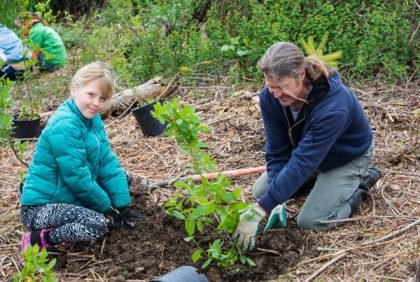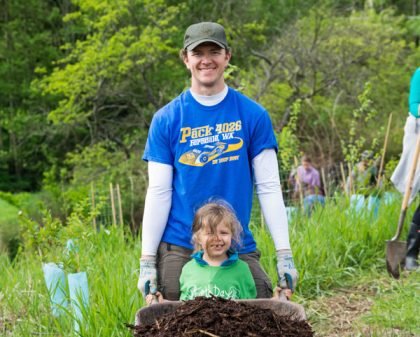 Planting at a past Terrell Creek community work party. Photo by Daniel Broker-Bulling.
Planting at a past Terrell Creek community work party. Photo by Daniel Broker-Bulling.
By Stefanie Donahue
Volunteers will take part in what’s become a years-long process to restore the salmon habitat in Terrell Creek at a community work party on April 8. With nearly two decades of work completed, representatives from local environmental advocacy groups look back.
Located in northwestern Whatcom County, Terrell Creek spans about 9 miles and stems from Lake Terrell; the watershed drains into Birch Bay. Historically, the area from Point Whitehorn to Boundary Bay was inhabited by the Semiahmoo tribe and the creek was known for its abundance of coho salmon and steelhead trout.
Since then, more than half of the land directly bordering Terrell Creek was harvested for timber and converted to farmland and the thriving fish population fell
dramatically.
Efforts to restore the habitat began in 1999 after questions about the health of the creek and existing fish population spurred a detailed habitat assessment led by the Bellingham-based Nooksack Salmon Enhancement Association (NSEA). The study discovered multiple constraints on salmon habitats caused by, in part, unhealthy vegetation and impenetrable passageways, said NSEA executive director Rachel Vasak.
Volunteers and a number of agencies throughout the county have since come together to improve and restore water quality and habitat in the creek.
 Photo by Daniel Broker-Bulling
Photo by Daniel Broker-Bulling
NSEA, the Whatcom Conservation District, Birch Bay Watershed and Aquatic Resources Management District
(BBWARM) as well as property owners along the creek, including BP, the Washington Department of Fish and Wildlife, the Washington State Parks System and other private owners have contributed to the cause. In 2003, an inspired group of local volunteers created the Chums of Terrell Creek group to further recovery efforts in the area.
“We really think of this as a stewardship effort,” Vasak said.
Biannual community work parties along the site have taken place since 2003. Often, they include an educational component to allow the public to learn more about the watershed. Most of the time is spent in the dirt, planting native trees and shrubs along areas bordering the water, also known as riparian zones.
Volunteer efforts have helped to educate nearby landowners, particularly small hobby farmers, about best management practices, said Aneka Sweeney, education specialist with the Whatcom Conservation District. Things like vegetative buffers, manure/composting storage, improved septic systems and livestock fencing help to prevent runoff and exposure to harmful bacteria such as E. coli, she said.
“It’s hard to think of yourself as the source of pollution,” Sweeney said, but many landowners have stepped up to the plate. Several have made use of incentive programs like the Conservation Reserve Enhancement Program (CREP), for example, to receive assistance in property management and to learn about conservation practices.
In recent years, organizers, volunteers and agencies from throughout the area have celebrated several milestones at Terrell Creek as result of their hard work. BBWARM has improved and installed multiple stormwater systems in the Birch Bay watershed, nearly 20,000 native plants have been introduced to the creek habitat, several fish barriers have been replaced and an estimated 5 miles of stream has been restored.
But there’s still work to do, Sweeney said.
To get involved, join the upcoming community work party. It takes place from 9 a.m. to noon on Saturday, April 8 on Jackson Road, which is located 7 miles west of exit 266 on I-5 north. NSEA will display signs to direct volunteers to the correct location.
Organizers will provide tools, gloves, snacks and water; volunteers are encouraged to wear weather-proof clothing. Individuals under the age of 18 must be accompanied by an adult or are required to sign a liability form.
To learn more about the Terrell Creek work party, http://bit.ly/2odqK1v.
Comments
No comments on this item Please log in to comment by clicking here